
He’s the forgotten hero of modern medicine, but the boy from Bendigo who solved the riddle of a killer disease more than 50 years ago has finally been recognised by his country. John Gorman, who pioneered the treatment of Rh disease in the 1960s, has been given Australia’s highest honour, an AC, for eminent service to humanity.
It caps a life of extraordinary achievement; a man of medical marvel who turned a poison against itself to beat an insidious, lethal condition that was killing babies by the tens of thousands.
“It’s one of the great advances of modern medicine,” says Dr Danny Challis, a maternal fetal medicine specialist at Sydney’s Royal Hospital for Women. “It took a terrible, horrible condition and basically eliminated it.”
It involved a vial of precious human serum, an ice box and a clandestine flight.
If John Gorman had had his way, he would never have studied medicine. “If I had my druthers, it would have been engineering”, the 93-year-old says. But both his parents were GPs and they were very eager for him to follow suit, so he chose the path of least resistance.
After graduating from the University of Melbourne and a year’s stint at St Vincent’s Hospital, opportunity beckoned. Three of his good mates – fellow doctors John Hamilton, Hubert de Castella and Sam Breen – had decided to head overseas, first to Europe and then to New York.
Gorman did not need much encouragement to join them. “I was always fascinated by America. I thought America was the place to be. That’s where the action was,” he says. “And then I was very interested in the American cars. I couldn’t wait to get to New York and get my Pontiac.”
It was 1955 and Gorman found himself working in paediatrics at the St Francis Hospital in the south Bronx, a tough part of town. But then he landed a job at the prestigious Columbia Presbyterian Hospital as resident pathologist. “I got totally hooked on laboratory medicine,” he says. “You realise, ‘This is it. This is fantastic’. The pathologist really knows more about a patient than anybody.”
Gorman had come across Rh disease back home in Melbourne. At the time, it was responsible for one in 10 fetal deaths. It was the silent killer. “The mother would be perfectly healthy, and say, 35 weeks [pregnant] have a stillbirth out of the blue. It was very scary.”
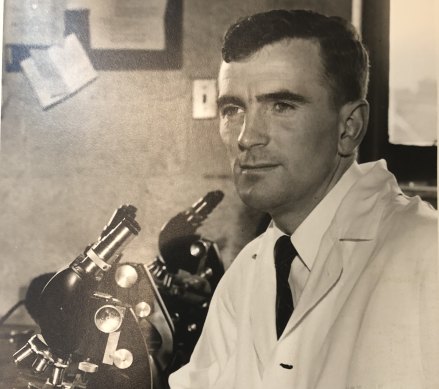
Medicine was not John Gorman’s first choice. He went into the field to please his parents.
Immune response gone wrong
In Rh disease, a mother’s blood is incompatible with the blood of her baby. While there are four blood types – O, A, B and AB – each is either positive or negative, depending on the presence of the Rh-D protein in the red blood cells.
So O+ means it has the Rh-D protein whereas B- means it’s without the protein. About 17 per cent of the population is Rh negative. So when an Rh-negative woman becomes pregnant to an Rh-positive father there’s a high chance her baby will be Rh-positive.
In that combination, when the baby’s red blood cells cross the placenta into the mother’s circulation – even in minuscule quantities – it triggers an immune response in the mother when she next encounters Rh-positive blood, usually when she is pregnant with her next child.
“The mother makes an antibody against the baby’s red cells – this is Rh antibody – and that antibody crosses the placenta back into the baby’s system and attacks the baby’s red cells and destroys them,” Gorman explains. “Antibodies are usually good, but in this case, the antibodies are doing harm.”
If the baby is not stillborn, it is born very anaemic, brain-damaged or with cerebral palsy.
Loading
The anti-vaccine
John Gorman’s genius idea was inspired by a 23-word sentence in Australian Nobel laureate Howard Florey’s textbook General Pathology, which he had come across as part of his teaching role as the resident pathologist at Columbia Presbyterian.
“The presence of circulating antibody, whether produced actively or received passively, depresses and may completely inhibit the immune response to the relevant antigen,” it reads.
“I knew immediately, within a few minutes, that this would prevent haemolytic disease,” Gorman says. “That the very antibody that’s harming the babies is what would prevent this disease.”
He chuckles at how the concept appeared to run counter to the central maxim governing medicine: Do No Harm. “You could say, John, you’re crazy. You’re going to give the same thing that’s killing the babies?”
But this was an idea to stop a mother mounting an attack on her unborn baby. A sort of anti-vaccine. “Vaccines cause an immune response that will protect you from the bacteria and viruses, but we wanted to stop the immune response, not stimulate it,” Gorman says.
A great theory, for sure, but who on earth could it be safely tested on?
Prison testing
Gorman’s research partner Vincent Freda convinced the governor at New York’s notorious Sing Sing maximum security prison to allow him to pitch for Rh-negative volunteers among the male inmates. “I don’t think that would be acceptable today to use the prisoners,” Gorman says.
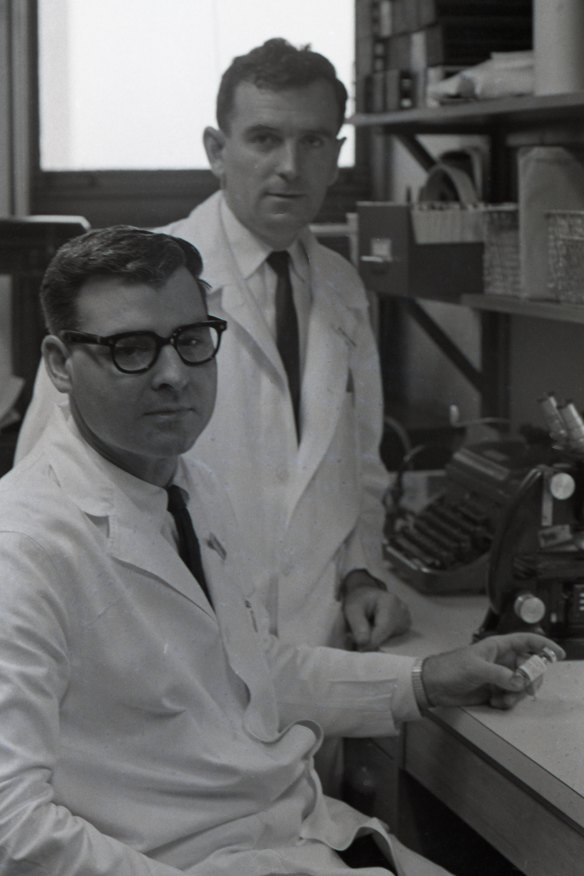
John Gorman and Vincent Freda.
The warden asked Gorman and Freda not to visit Sing Sing on a schedule out of concern the prisoners might plan an escape. “We found that they were very nice people, I must say. Of course, we were dealing with the volunteers, so we’re probably selecting for nicer people, but they couldn’t have been more co-operative and polite.”
The 36 volunteers were each given Rh-positive blood to trigger the antibody and within 72 hours half the volunteers were given anti-D serum, known as RhoGAM.
“At the end of the study it was clear – all 18 that did not get RhoGAM got antibodies, and all 18 that did get RhoGAM, none of them got antibodies. So we had a 100 per cent protection of those 18 volunteers ... startling, early good statistics.”
However, experimenting on men is one thing – testing on pregnant women brings an entirely different risk profile.
The perfect candidate
“He needed a guinea pig – preferably a family guinea pig,” says Kath Gorman, John’s sister-in-law. Kath was the perfect candidate. She was pregnant with her first child, she was Rh-negative and her husband, John’s brother Frank, was Rh-positive.
Being a nurse, and Frank a doctor, they were well aware of the peril posed by Rh disease to the couple’s desire for a big family. Frank and John’s father in Bendigo had been following the trials at Sing Sing and encouraged the couple to consider having the anti-D injection. “It wasn’t without risk, but then again, is anything without risk?” Kath says. “And we trusted John, so we thought, ‘Oh well, we’ll go for it’.”
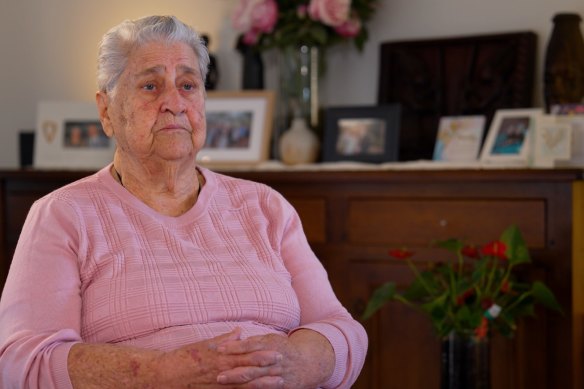
Kath Gorman became a test case for her brother-in-law’s theory.Credit: Nine
But Kath and Frank were in England at the time and John was in New York. Posting experimental human serum packed in ice across the Atlantic wasn’t exactly legal. “It was a foam, blue and white box and with a lid sealed with Sellotape,” Kath remembers.
She and Frank had picked up the package from Heathrow Airport. “We were kind of breaking all kinds of export laws,” John says. “It was found afterwards it wasn’t authorised to ship an untested drug.”
It turns out the box had arrived in the nick of time. Kath was nursing the precious cargo on her lap on the drive home from Heathrow when she felt her tummy going hard. She was in labour and decided to go straight to hospital.
Kath and Frank then had to convince reluctant English doctors to give her the jab. Thankfully, one of the doctors was aware that competitors of Gorman and Freda at the University of Liverpool were also working on Rh disease. The doctor called them for advice and received the go-ahead. “They were a bit put out,” Kath says. “They didn’t like the idea of an American injection being given to an Australian woman in England. They sort of were hoping that they would have cracked it first.”
Kath received the injection shortly after Kieron was born. But the effectiveness of anti-D couldn’t be truly assessed until she had another child free of Rh disease.
Angus was born safely in 1965, becoming the world’s first baby to be protected from the lethal condition. “He was gorgeous. He was big. He roared like a bull. That’s why he got called Angus,” Kath remembers.
John Gorman’s medical breakthrough was big news worldwide, appearing on NBC’s Today Show with Barbara Walters in October 1967.
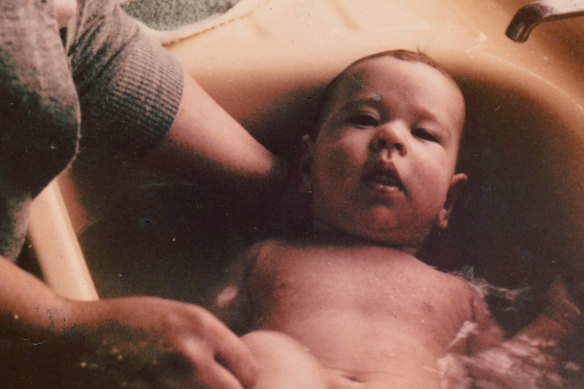
Angus Gorman was born healthy thanks to his uncle’s breakthrough.
‘Giving back’
Australia was the first country in the world to run an anti-D program to ensure every pregnant woman who needed it could receive it free of charge.
“It was a revolution in medicine,” says Robyn Barlow who was Rh project co-ordinator for the Blood Service, starting there in 1967. “Within 10 months of us knowing how to do this, we had immunoglobulin to be given to the mother to stop her making an immune response, so she didn’t destroy your future children.”
She recruited many of the early donors of anti-D, most of whom were women who’d suffered the heartbreak of losing babies – one woman had lost 10 babies. Barlow remembers vividly one conversation with a grieving woman. “I said ‘Why? Why do you want to do this?’ It was so important to her. She said, ‘You have given me hope when I felt hopeless and use when I felt useless’.”
Nicole Mannix-Power is one of Australia’s very few remaining female anti-D donors. “I love to give back. I buried a child and I don’t want anyone to have to do that. It’s horrendous,” she says.
Now most of the 170 or so anti-D donors in Australia are men who, like the Sing Sing volunteers in the 1960s, are dosed with Rh positive blood to stimulate production of the antibody.
But some, like Sam Ryan, developed the antibody after a near-death experience. “I was 17. I was driving to work out near Forbes, about three hours out of Canberra, two and a half hours into that trip, I fell asleep, crashed into a tree at 100km/h.”
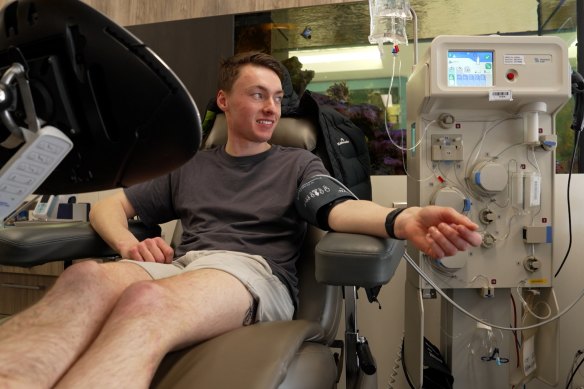
Sam Ryan saves lives with his blood donations.Credit: Nine
Sam was found unconscious and catastrophically injured; his pelvis and right leg shattered. He was bleeding profusely. Paramedics had to pump 22 units of blood into his body – that’s seven litres of blood, which is about a litre-and-a-half more blood an average man has in his body.
Sam has O- blood but some of the units given to him were Rh positive, which caused his immune system to generate anti-D antibodies – a fact Sam didn’t discover until he started donating blood and plasma himself – in honour of the 22 strangers whose blood saved his life.
“My blood is incredibly rare,” he says. “I know that every time I go to donate, there are dozens of anti-D injections that are able to be made, which is dozens of babies lives that are saved,” Sam says.
More to do
While Rh disease has been almost eradicated in the developed world, thanks to the provision of anti-D becoming standard practice in maternal healthcare, it remains a big killer in the developing world.
And it’s on this front that John Gorman says his life’s mission is incomplete.
Gorman is part of the World Initiative for Rh disease Eradication (WIRhE), a consortium of scientists and healthcare professionals dedicated to expanding availability of anti-D to the 50 per cent of the world’s Rh negative mothers who have no access to the treatment. “My interest now is, in the very short time I got left here is, is to see if we can take care of the others,” Gorman says.
Rh disease is estimated to be responsible for 160,000 fetal and neonatal deaths a year and 100,000 cases of lifelong disability, including hearing loss and cerebral palsy. The fact it can be prevented so effectively and relatively inexpensively frustrates Gorman.
Gorman says he has come up with his greatest invention – a way to generate revenue to fund WIRhE. He calls it Prometheus and promises it would not only save millions of more lives but generate billions of dollars in revenue. It will need some deep-pocketed investors and the involvement of the five companies who monopolise automatic blood lab testing: Siemens, Roche, Beckman Coulter, Abbott and Sysmex.
Gorman has established a portfolio of global patents for new blood analysers which he wants the big five to embrace. Under his plan, half the royalties from the patents would go to WIRhE to fund its Rh program.
John Gorman honoured
More than six decades after Gorman began his revolutionary research, he has been finally honoured by his country of birth for his services to humanity, appointed Honorary Companion (AC) in the General Division at a ceremony near his home in Del Mar, California, on August 30.
Former prime minister Kevin Rudd, Australia’s ambassador to the United States, told those assembled he was “always taken by extraordinary stories”.
“The silent throng who I represent in today’s presentation ceremony are the millions of babies born healthy across the world,” Rudd told the ceremony, promising to assist Gorman and WIRhE fulfil their anti-D ambition in the developing world.
Loading
“I’d certainly like to sit down and discuss with your colleagues how we might be able to help with introductions of the World Health Organisation, other national institutions, agencies, to see what can be done.”
That’s a high-end pledge welcomed by WIRhE executive director Dr Steven Spitalnik, a professor of pathology at Columbia University. “It’s ironic that at the World Health Organisation, this drug, Rh immune globulin (anti-D) is on the list of essential medicines, but in their list of diseases, Rh disease, haemolytic disease of the newborn, is not mentioned,” Spitalnik said.
“That’s an example on a global scale that even the WHO, which represents the world, doesn’t recognise this as a disease.”
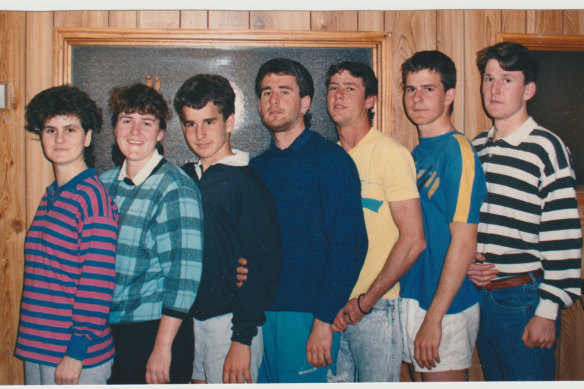
Kath Gorman’s seven children: Kirsten, Friedel, Jacob, Angus, Ian, Giles and Kieron.
The greatest gift
And what of Gorman’s first Rh patient, Kath Gorman? She took anti-D for each of her pregnancies. “I produced six. And we adopted Ian, which gave us seven,” Kath says.
Not quite the football team her husband Frank wanted, but she’s delighted.
“I look over them and sort of think how lucky we were that we got them.”
Nothing like it: the gift of life.
Andrew Probyn’s report on John Gorman, Humble Hero, was broadcast on A Current Affair on October 30.
Start the day with a summary of the day’s most important and interesting stories, analysis and insights. Sign up for our Morning Edition newsletter.




























